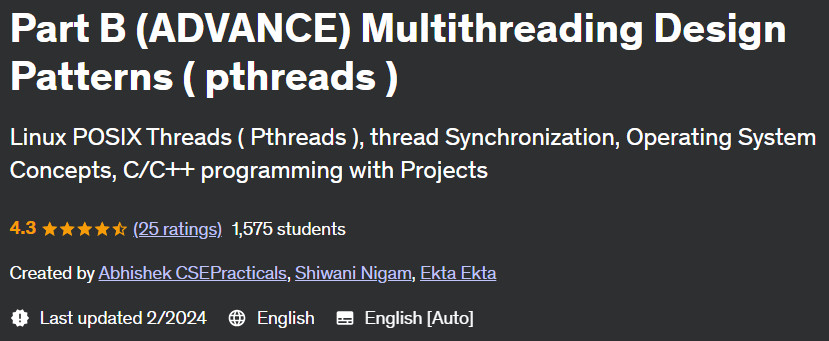Description
Part B course (ADVANCE) Multithreading Design Patterns (pthreads). Course B (ADVANCE) multithreaded design patterns (pthreads). This course is a sequel to the Master Class-Multithreading & Thread Synchronization – C/C++, and should only be taken once the introductory course has been completed, unless you have a reasonable understanding of how Mutexes and Condition Variables work. In this course, we will implement advanced thread synchronization data structures and multi-threaded software patterns with some advanced thread synchronization based problem solving. This course uses POSIX strings, so it’s a Linux only course. We need to build on the knowledge we have gathered from the introductory course. *** Note however that this course is very conceptual and the concepts learned can easily be applied to any programming knowledge that supports Multithreading. *** So Java, C#, Python, Go, Kotlin programmers don’t hesitate to register for this course, you can write your codes based on the concept discussed. This course is unique and the only one of its kind. The level of this course is from intermediate to advanced. Table of Contents
1. Topic management
2. Pause and resume topics
3. Thread Pools/Work Crew Model
4. Thread barriers
5. Queuing model
6. Recursive Mutexes
- What are recursive mutexes?
- When to use regular mutexes?
- Implement your own recursive mutex
7. Read and write lock
- What are Read-Write locks?
- What is the benefit of it?
- Implement your own Read-Write lock
8. Monitor
- Implement the Reader-Writer monitor
- Solving the bridge problem using the monitor
- Instructions for writing monitors
- Case study: implementation of covid vaccination stimulus using monitor
*** Completed so far as of March 2, 2022 **
9. Assembly line model
10. Diagnosis and prevention of deadlock
11. Other related courses in several disciplines
- Timer design
- Designing multi-threaded TCP servers
- Asynchronous programming
Unplanned topics:
11. Limited waiting
12. FIFO semaphores (strong).
13. Synchronization of event pairs
14. Synchronization between processes using semaphores
15. Forking a multi-threaded program
Although we use C to illustrate the concepts, the concepts are suitable for any programming language. This course is equally valuable for C++ programmers. Other language programmers may also find this course useful as we explain Multithreading concepts close to ground zero levels with No Abstraction. In each step of this series of courses, you will have to write a lot of multithreaded code. So be ready to master Multi-threading. During the trip, we will cover several interview topics and questions to prepare you for the interview.
What you will learn in Part B (ADVANCE) Multithreading Design Patterns (pthreads) course
-
Basics of MultiThreading
-
Thread synchronization techniques
-
Writing secure subject codes
-
Standard subject problems – reader-writer problem
-
Detection and prevention of deadlocks
-
Advanced multidisciplinary concepts
-
Monitors, barriers, waiting line, assembly line
-
Thread pools, queues, barriers, monitors, assembly line
This course is suitable for people who
- Graduates and engineering graduates
- Working professionals and job seekers
- Freelancers, system engineers, developers
Course specifications Part B (ADVANCE) Multithreading Design Patterns (pthreads)
- Publisher: Udemy
- teacher: Abhishek CSEPracticals
- Training level: beginner to advanced
- Training duration: 8 hours and 40 minutes
- Number of courses: 76
Course headings
Prerequisites of Part B (ADVANCE) Multithreading Design Patterns (pthreads) course
- Finish Prequel Course
- C language is MUST
- Zeal to learn and excel
- Enthusiasm to write lots of code
Course images
Sample video of the course
Installation guide
After Extract, view with your favorite Player.
English subtitle
Quality: 720p
download link
File(s) password: www.downloadly.ir
Size
3.2 GB
